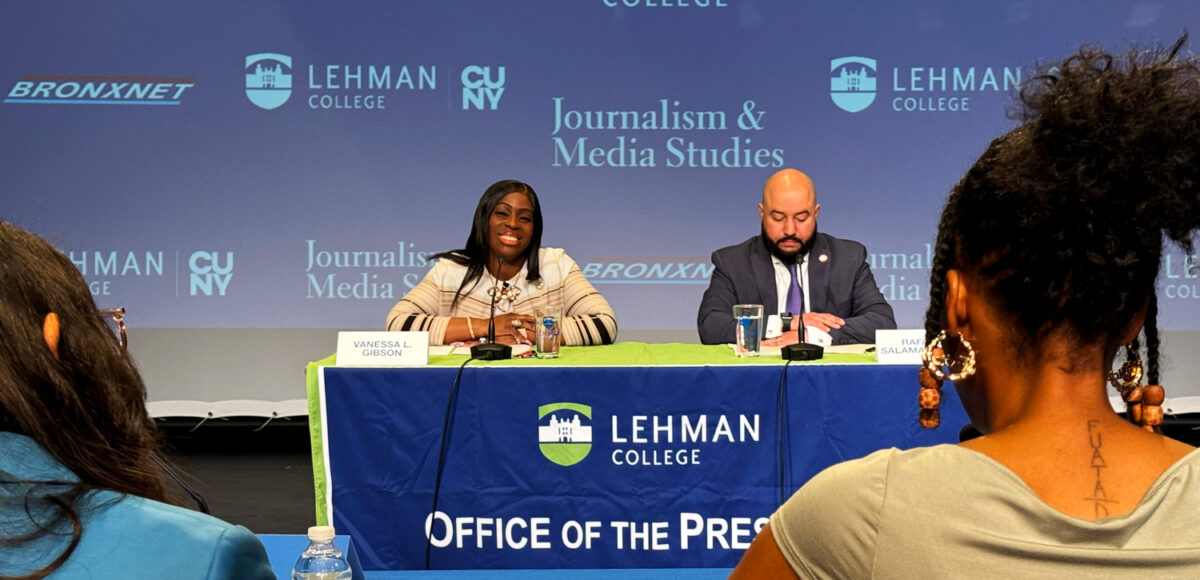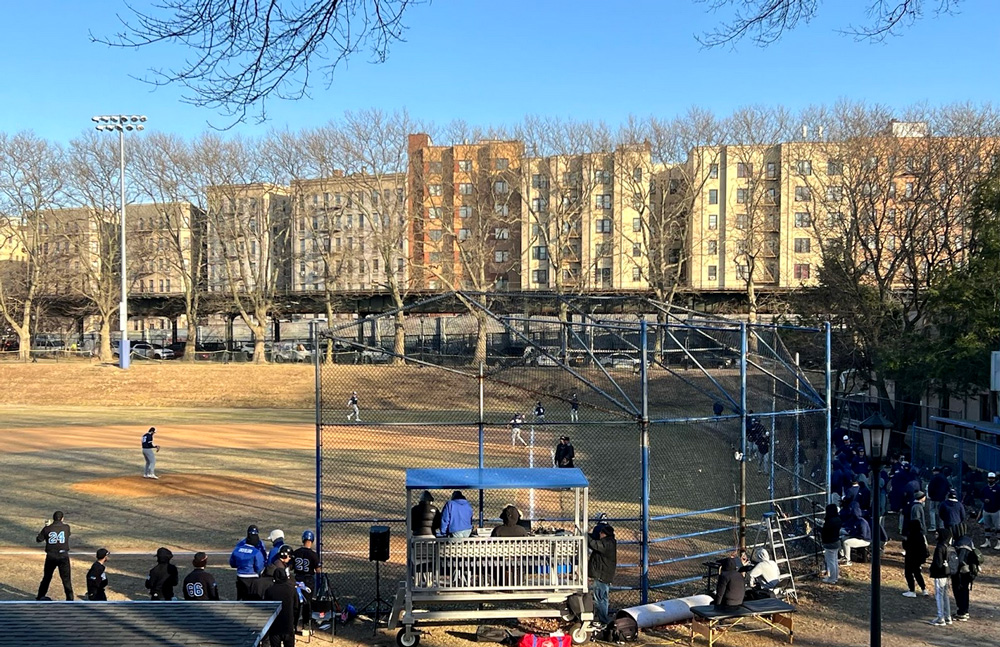By Amen Dilawar
“I’m an asthmatic because of my environment,” NYC City Council Member Rafael Salamanca said at the Bronx Borough President Candidate Forum.
The Bronx Borough President Candidate Forum was held April 29 in the Black Box Theatre at Lehman College. The forum featured incumbent Bronx Borough President Vanessa Gibson and her Democratic challenger, City Council Member Rafael Salamanca Jr. in a student-led discussion moderated by Gary Axelbank of BronxNet TV. The candidates responded to questions on affordable housing, health disparities, environmental impact, education, youth employment, gun violence, homelessness, and food insecurity.
“My 10-year-old is an asthmatic,” said Salamanca. “I actually have to walk around with my asthma pump just in case I were to get an asthma attack. In my car, I have an asthma nebulizer in case my son also gets an asthma attack as well.” The air in Hunts Point, a neighborhood long burdened by truck traffic and industrial pollution, influenced his childhood and now impacts his family.
Bronx Borough President Vanessa Gibson said she had a record of action and sustained efforts. “As the Bronx Borough President for the past three years, I have shown up time and time again, not just during election time, but all the time. I’ve knocked on doors. I’ve been with mothers and fathers that are mourning the loss of their children. I’ve been in schools and cultural institutions. I’ve invested millions of dollars. I focused on policy, real results,” said Gibson.
While Salamanca spoke from personal experience, Gibson pointed to her ongoing efforts to address the borough’s systemic challenges through both community presence and targeted investment. However, both candidates adequately responded to each question with transparency and established credibility by conveying how their characters shape their policies and priorities.
Although both candidates specifically addressed housing, healthcare, and education thoroughly by discussing expansive platforms coupled with their past efforts, an issue that unified their vision was employment and opportunities. Amid the scars of systemic disinvestment, they envision jobs not just as economic drivers but as fundamental to prevent violence, eradicate generational poverty, keep youth out of jail, and bring dignity to marginalized communities. They propose work as healing for the borough.
Gibson argued for further investment in youth employment and economic opportunity as public safety strategies. “The most important social program we invest in is a job,” she said. “Gun violence is not just about police presence, it’s about programs and recreation. Instead of being reactionary, we should intervene. We should love youth, give them support, keep them out of the criminal justice system, and give them opportunities so that they can be positively engaged and become fruitful, productive members of our community.”
Salamanca echoed that sentiment and also mentioned that a job can be the difference between stability and shelter life, between a Bronx teen joining an apprenticeship or entering the justice system. “We must shut down the hubs that fuel crime, but we also must build opportunities,” he said. He highlighted efforts like lifeguard training at a newly reopened community pool, adding, “That’s an opportunity during the summer. The city will hire them.”
In addition to safety, both candidates challenged the notion that higher education is the only path to success. They referenced non-college pathways such as apprenticeships, trade programs, vocational training, and paid internships. Salamanca shared his own educational journey. “It took me two tries to get my GED. I went to Monroe, then Lehman but had to choose between work and school. It’s a challenge.”
Similarly, Gibson advocated for expanding technical and trade education. “We need construction jobs ready and apprenticeship opportunities. We need the electricians, the painters, the plumbers, the operating engineers. We need those skills for today as well as tomorrow. That’s how we build a workforce that reflects our community,” she said. This refutes meritocratic norms and indicates how they are legitimizing blue-collar work and redefining what ambition looks like, especially for Bronx youth who have been historically tracked into failure.
Jobs, they asserted, are not separate from the housing crisis. In fact, they are a major solution to it. “Housing opportunities must come in with a job plan,” Gibson said. “We have to give families real pathways to the middle class.” She called for cutting red tape and addressing stagnant wages to help rent-burdened residents remain in their homes. Even while addressing the topic of gun violence, she stated that the answers are jobs, programs, and recreation—programs like NYPD Options, Summer Youth, Compass, Sonic, and Beacon. Both candidates see employment as a way to promote stability and justice among families and as a potential solution to most issues.
Salamanca emphasized legislative action. “At the end of 2019, one of the most monumental bills that I was able to pass was called the 15% homeless set-aside,” he said. “It required every developer getting funding from the city, even if it’s $1, to set aside 15% of their units for homeless families that were ready for independent living.” He said the bill stemmed from lived experience: “Being a kid from the South Bronx, I had many friends that were in the homeless shelter system.”
He also underlined inequity in his district. “My city council district has over 60 homeless shelters,” he said. “When you go to my public schools, there are schools where 50% of the students live in shelters, and they don’t know if they’re going back to the same room that night.” It is evident that their personal history infused every policy pitch.
These experiences are powered by constant efforts and ongoing intervention. “I believe in supporting hydroponic labs, where I was at a school in District 9 yesterday, and they are growing fruits and vegetables in their school,” said Gibson. “The best way to answer food insecurity is through the lens of young people—using young people who want to learn and think about food equity because it’s a justice issue.”
Both candidates placed Bronx youth at the center of their visions. Gibson credited her administration with reducing youth unemployment from 26.6% to 6.8% in three years. “Our kids are amazing, ambitious, driven, determined, and smart. All they need is access and opportunity and doors to open so that they can show us their skills and shine,” she said.
Salamanca called attention to his investments in hands-on youth programs. “We brought in a vocational construction class,” he said. Twenty-five local kids graduated last week. I invested $200,000 in the YouthBuild Program. I have two paid internships every year, and I will expand the Summer Youth Employment Mentorship Program.” Whether through youth investment, housing reforms, food access, or public health, their visions converge on a singular truth: when you build opportunity in the Bronx, you provide hope and construct a better tomorrow.
Moreover, both candidates proposed various solutions to the topics discussed. Gibson highlighted public-health initiatives, including HIV roundtables, a diabetes task force, harm-reduction strategies for substance abuse, and investments in school-based health clinics for trauma-informed care. Salamanca accentuated environmental policy, pointing to the Blue Highway Initiative, which would shift cargo deliveries to barge routes and remove 1,000 trucks a month from the Hunts Point community. He also touted annual investments in Health Bucks—a program that provides low-income New Yorkers with coupons to purchase fresh produce at farmers markets—and a borough-wide food equity plan to connect farms, schools, and food pantries.
In their final remarks, Council Member Salamanca returned to the urgency of economic survival and Borough President Gibson directed the audience to what leadership means in moments of crisis.
Salamanca looked the audience in the eye and asked, “Today, are your economics or the economics of the Borough of the Bronx better than they were four years ago? For too many families, the answer is no. We deserve leadership that delivers, not just talks—leadership that knows our neighborhoods, has fought for them, and has never given up.”
Gibson closed with a promise founded upon presence and service. “That is the leadership you get with us,” she said, “committed, consistent, dedicated, and steady leadership that has shown up for not just the last three years, but all of my life as a public servant.”








No comments
Sorry, the comment form is closed at this time.